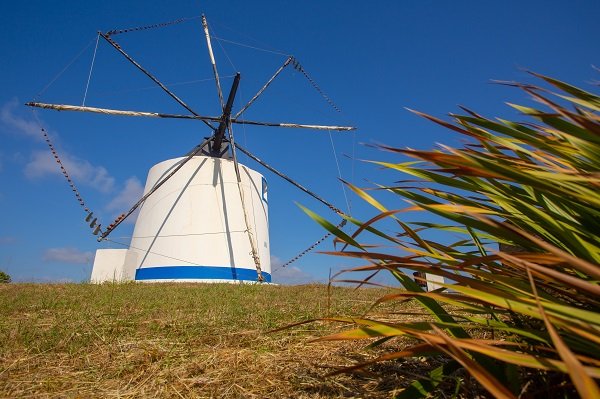Travel Portugal and be amazed by the variety of windmills. From modern wind turbines, to ancient mills dotting the hillside — they are part of the landscape. Today many have been restored, and others are for rent as vacation houses. There are several groups of windmills that can be explored around Santiago de Cacem,Odemira and Grândola.
The Portuguese word "moinho” comes from the Latin molinum, which means to grind, crush cereals or use a millstone. Water mills first appeared in the 2nd century with the Romans, who later spread it across Portugal. The idea caught on: By the 1960s there were more than 10,000 mills in operation in Portugal, 7,000 of which were water mills and 3,000 windmills. Vital to every village, the windmills in Portugal ground corn and wheat to make flour for bread and feed.
Between the months of May and July, when the fields were harvested, the mills turned out flour. Windmills were also centers of meeting and social life. Farmers transported grain to the mill in sacks on the back of donkeys or in carts pulled by oxen. And in time they waited between grinding the cereal and its transformation into flour was a social time.
Windmills of Odemira
The Moinho de Vento of Odemira is a historic mill in the Moinhos Juntos complex, with another windmill located nearby, in ruins. The mill is still used to grind grain and has a small shop. It is not unlike most in the area, with a simple circular building, built in stone trimmed and plastered, with the exterior walls whitewashed and painted with blue stripes. The roof is made of galvanized plates, with a mast, being supported by a wooden structure on the inside in order to allow its rotation. The mill has four triangular sails, joined by braces and mounted on eight rods, which, through the mast, give movement to the interlocking wheel, which in turn moves the reel, connected to the millstones.
The Windmill of Agonia, also called the Windmill of Carrasqueira, is in the parish of São Luís. This windmill follows the traditional model of a tower mill in the Mediterranean region, with a fixed tower and a rotating hood. It is part of the protected area of the Sudoeste Alentejano e Costa Vicentina Natural Park and the Costa Sudoeste Site of Community Interest, within the Natura 2000 Network.
The Moinho de Vento da Pereira is in São Luís, it is a windmill with a fixed tower and rotating hood, a type of structure common in the Mediterranean region. The mill was probably built in the 19th century. It offers a panoramic view over the surrounding lands, with views of the Serra de Monchique and the Sudoeste Alentejano e Costa Vicentina Natural Park.
The Longueira Windmill in the Largo dos Moinhos, in the center of the village of Longueira. A simple circular building, built in stone trimmed and plastered, whitewashed in white tones and decorated with blue bars on the basement and around the door and windows. It was built in 1920, and has been restored.
The Verdigueiras windmill in Luzianes-Gare consists of a windmill, with a simple circular style set on top of a hill, and probably built in the first half of the 20th century.
The Moinho de Vento das Quintas, also known as Moinho de Vento da Lage, in São Luís, is one of several mills with the mills of Agonia, Pereira and Toca do Mocho. The mill was built in 1923.
The Windmills of Grândola
In the town of Grândola, given the proliferation of watermills, windmills only appeared in the 18th and 19th centuries, and all of them of the fixed model, the most common in this area of the country. Today there are three wind mills operated in the town of Grândola.
Although different in the details, these mills had a fixed truncated conical tower, in masonry, two floors with hood, mast, sails, interlock wheel, frechal, windlass, millstones, and cambreiros.
To make up for the temporary lack of wind, some 20th century mills, such as those in Santa Margarida, Fontainhas, Atalaia do Viso and Nespereira, were adapted to mill with energy supplied by combustion engines.
Grândola’s windmills, solitary atop their hills, had the air of a sentry, guarding the village. For centuries, the millers controlled the winds in the sails of their mills, turning the wind power into bread.
The Windmills of Santiago do Cacém
The windmill wealth of Santiago do Cacém is due to the size of the town and its rich fields that once grew grains and wheat. Moinho De Vento Da Quintinha sits, restored, on a hillside a few minutes from town. Built in 1813 the windmill has been restored and is a great place to see how these mills worked, and what role they played in the community.
Museu Da Farinha De São Domingos is a flour museum set in a former mill, the perfect place to see the milling process. Elaborate wooden mechanisms with grinding drums connected to belts still grind as they did decades ago.
Nearby, the windmill of Castro Verde in Largo da Feira, near Castro Verde. It was built during the first half of the 20th century, and in 2003, restoration work on the mill began, during which the grinding mechanisms were restored. Today, the mill is a museum center, with its own mill.



